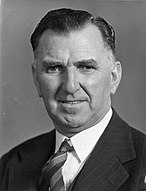New Zealand general election, 1946
|
|
|||||||||||||||||||||||||||||||||||||
|---|---|---|---|---|---|---|---|---|---|---|---|---|---|---|---|---|---|---|---|---|---|---|---|---|---|---|---|---|---|---|---|---|---|---|---|---|---|
|
|||||||||||||||||||||||||||||||||||||
|
|
|||||||||||||||||||||||||||||||||||||
|
All 80 seats in the New Zealand Parliament 41 seats were needed for a majority |
|||||||||||||||||||||||||||||||||||||
| Turnout | 1,047,205 (93.5%) | ||||||||||||||||||||||||||||||||||||
|
|||||||||||||||||||||||||||||||||||||
|
|||||||||||||||||||||||||||||||||||||
The 1946 New Zealand general election was a nationwide vote to determine the shape of the New Zealand Parliament's 28th term. It saw the governing Labour Party re-elected, but by a substantially narrower margin than in the three previous elections. The National Party continued its gradual rise.
The Labour Party had been in government since winning the 1935 elections, and had been re-elected twice. However, the National Party had managed to overcome the internal problems which had once troubled it, and now presented a credible threat to Labour. National's leader, Sidney Holland, was proving more effective than his predecessor, while the Prime Minister, Peter Fraser, was weary and in poor health. The after-effects of World War II, including ongoing shortages, were affecting the government's popularity.
The next census was scheduled for 1946, but the government brought it forward to Tuesday 25 September 1945, so that the results could be used for the 1946 electoral redistribution prior to the planned 1946 election. The 1946 electoral redistribution had to take ten years of population growth and movements into account. The North Island gained a further two electorates from the South Island due to faster population growth. The abolition of the country quota through the Electoral Amendment Act, 1945 reduced the number and increased the size of rural electorates. None of the existing electorates remained unchanged, 26 electorates were abolished, 19 electorates were created for the first time, and six former electorates were re-established.
...
Wikipedia


